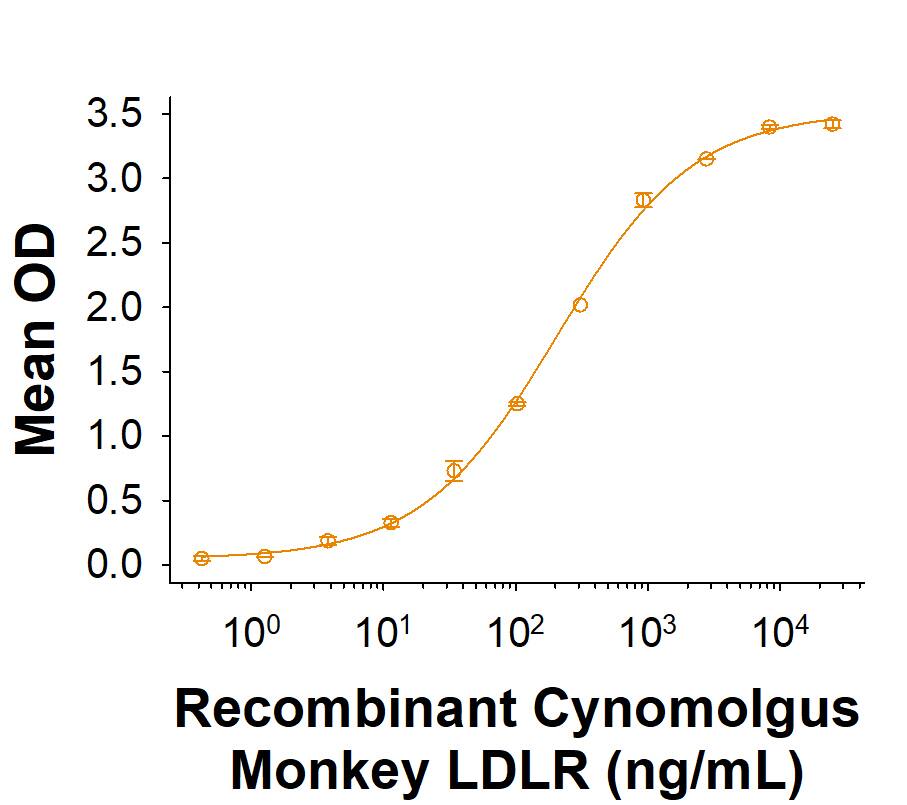Recombinant Cynomolgus Monkey LDLR His-tag Protein, CF
R&D Systems, part of Bio-Techne | Catalog # 11151-LD

Key Product Details
Product Specifications
Source
Human embryonic kidney cell, HEK293-derived cynomolgus monkey LDLR protein
Ala22-Gly788, with a C-terminal 6-His tag
Ala22-Gly788, with a C-terminal 6-His tag
Purity
>95%, by SDS-PAGE visualized with Silver Staining and quantitative densitometry by Coomassie® Blue Staining.
Endotoxin Level
<0.10 EU per 1 μg of the protein by the LAL method.
N-terminal Sequence Analysis
Ala22
Predicted Molecular Mass
86 kDa
SDS-PAGE
125-140 kDa, under reducing conditions.
Activity
Measured by its binding ability in a functional ELISA.
When Human LDL is immobilized at 4.00 µg/mL (100 µL/well), Recombinant Cynomolgus Monkey LDLR His-tag (Catalog # 111151-LD) binds with an ED50 of 30.0-300 ng/mL.
When Human LDL is immobilized at 4.00 µg/mL (100 µL/well), Recombinant Cynomolgus Monkey LDLR His-tag (Catalog # 111151-LD) binds with an ED50 of 30.0-300 ng/mL.
Scientific Data Images for Recombinant Cynomolgus Monkey LDLR His-tag Protein, CF
Recombinant Cynomolgus Monkey LDLR His-tag Protein Binding Activity.
When Human LDL is immobilized at 4.00 µg/mL (100 µL/well), Recombinant Cynomolgus Monkey LDLR His-tag Protein (Catalog # 11151-LD) binds with an ED50 of 30.0-300 ng/mL.Recombinant Cynomolgus Monkey LDLR His-tag Protein SDS-PAGE.
2 μg/lane of Recombinant Cynomolgus Monkey LDLR His-tag Protein (Catalog # 11151-LD) was resolved with SDS-PAGE under reducing (R) and non-reducing (NR) conditions and visualized by Coomassie® Blue staining, showing bands at 125-140 kDa.Formulation, Preparation and Storage
11151-LD
| Formulation | Lyophilized from a 0.2 μm filtered solution in PBS with Trehalose. |
| Reconstitution | Reconstitute at 200 μg/mL in PBS. |
| Shipping | The product is shipped at ambient temperature. Upon receipt, store it immediately at the temperature recommended below. |
| Stability & Storage | Use a manual defrost freezer and avoid repeated freeze-thaw cycles.
|
Background: LDLR
References
- Go, G.W. and A. Mani (2012) Yale J. Biol. Med. 85:19.
- Ren, G. et al. (2010) Proc. Natl. Acad. Sci. USA 107:1059.
- Bujo, H. and Y. Saito (2006) Arterioscler. Thromb. Vasc. Biol. 26:1246.
- Gent, J. and I. Braakman (2004) Cell. Mol. Life Sci. 61:2461.
- Begg, M.J. et al. (2004) Eur. J. Biochem. 271:524.
- Stolt, P.C. and H.H. Bock (2006) Cell. Signal. 18:1560.
- Defesche, J.C. (2004) Semin. Vasc. Med. 4:5.
- De Castro-Oros, I. et al. (2010) Appl. Clin Genet. 3:53.
- Zhang, D.W. et al. (2008) Proc. Natl. Acad. Sci. U.S.A. 105:13045.
- Tavori, H. et al. (2013) Circulation 127:2403.
- Fischer, D.G. et al. (1993) Science 262:250.
- Mbikay, M. et al. (2020) Lipids Health Dis 19:17
- Roslan, Z. et al. (2019) J. Oncol. 2019:536302.
Long Name
Low Density Lipoprotein Receptor
Alternate Names
LDL R
Entrez Gene IDs
Gene Symbol
LDLR
UniProt
Additional LDLR Products
Product Documents for Recombinant Cynomolgus Monkey LDLR His-tag Protein, CF
Product Specific Notices for Recombinant Cynomolgus Monkey LDLR His-tag Protein, CF
For research use only
